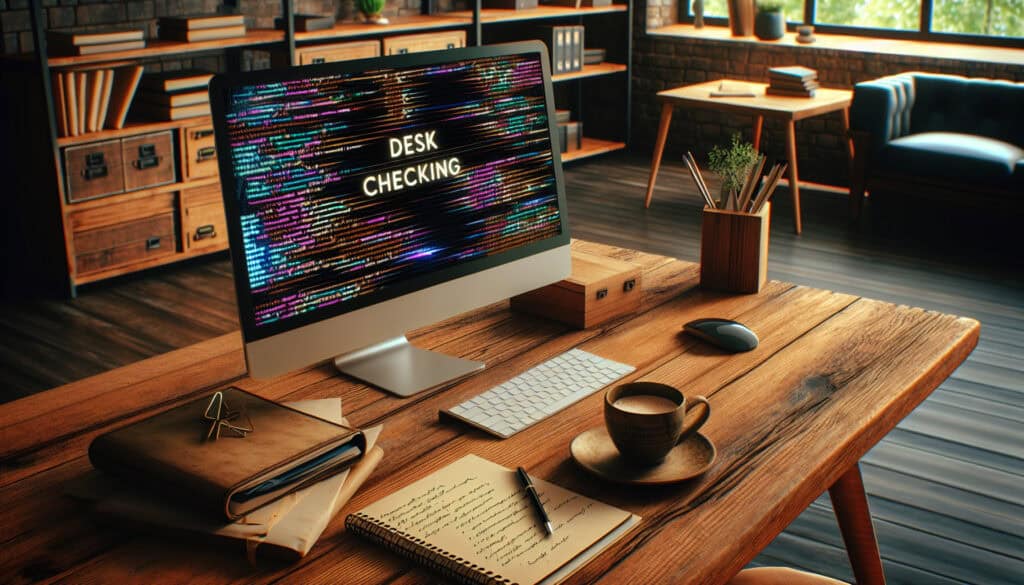An informal, manual process of reviewing one’s own source code or logic before it is compiled or executed.
- Méthodologies : Ingénierie, Fabrication, Conception de Produits, Qualité, Gestion des risques
Desk Checking

Desk Checking
- Méthodologie Agile, Amélioration continue, Prévention des erreurs, Assurance qualité, Contrôle de qualité, Ingénierie logicielle, Software Testing, Validation, Vérification
Objectif :
Comment il est utilisé :
- A developer sits at their desk and mentally walks through the logic of their code, line by line, to spot errors. It is the most basic form of code review.
Avantages
- Is simple, quick, and requires no special tools; helps developers catch simple mistakes before they affect others.
Inconvénients
- It is easy for developers to overlook their own errors due to familiarity with the code; it is not a substitute for a formal peer review or systematic testing.
Catégories :
- Ingénierie, Qualité
Idéal pour :
- A developer performing a manual, mental run-through of their own code to catch obvious errors.
Desk Checking is often employed in software development, particularly during the design and testing phases of a project, where developers meticulously review their own code to identify logical flaws or typographical errors before deploying the product. This technique not only serves individual developers but can also be effectively implemented in collaborative environments where team members engage in peer reviews. In industries such as finance, aerospace, and healthcare, where precision is paramount, the practice of Desk Checking becomes even more significant as a preemptive measure against costly errors or system failures. Participants typically include software engineers, quality assurance testers, and technical leads who can contribute different perspectives during the code verification process. The application of this methodology doesn’t require elaborate tools or platforms, making it an accessible practice in both established companies and startups, especially in agile development settings. Desk Checking also promotes a culture of accountability, encouraging developers to take ownership of their code by mentally rehearsing its execution, which can lead to more robust and reliable software solutions. Encouraging this practice early in the development cycle can save time and resources, thus enhancing project efficiency and ensuring the overall quality of the final product.
Principales étapes de cette méthodologie
- Read each line of code carefully, visualizing its execution.
- Identify and mentally track variable values as the code runs.
- Check conditional statements and loops for logical errors.
- Verify that function calls and their parameters are correct.
- Look out for off-by-one errors in iterations or index handling.
- Consider edge cases and how the code handles them.
- Check for unused variables or redundant code.
- Evaluate the code's flow and structure for readability.
- Reflect on consistency in naming conventions and formatting.
- Mentally replay scenarios to ensure expected outcomes occur.
Conseils de pro
- Focus on boundary conditions and edge cases during your mental walkthrough to ensure robustness against unexpected inputs.
- Incorporate peer feedback into your desk checking by verbalizing your logic to a colleague, which can surface hidden assumptions.
- Document your desk-checking thought process for future reference; this can be invaluable for recognizing recurring patterns in errors.
Lire et comparer plusieurs méthodologies, nous recommandons le
> Référentiel méthodologique étendu <
ainsi que plus de 400 autres méthodologies.
Vos commentaires sur cette méthodologie ou des informations supplémentaires sont les bienvenus sur le site web de la Commission européenne. section des commentaires ci-dessous ↓ , ainsi que toute idée ou lien en rapport avec l'ingénierie.
Contexte historique
1828
1850
1854
1854
1911
1928
1950
1827
1848
1850
1854
1895
1914
1943
1970
(si la date est inconnue ou n'est pas pertinente, par exemple "mécanique des fluides", une estimation arrondie de son émergence notable est fournie)















Articles Similaires
Questionnaires sur les troubles musculo-squelettiques
Tests à plusieurs variables (MVT)
Analyse de régression multiple
Systèmes de capture de mouvement
Méthode MoSCoW
Test de la médiane de Mood